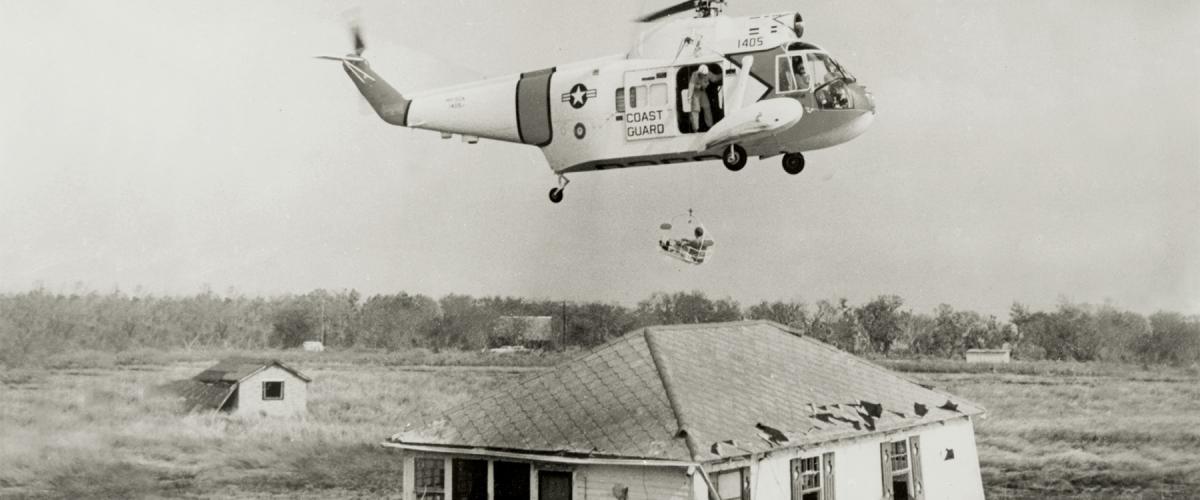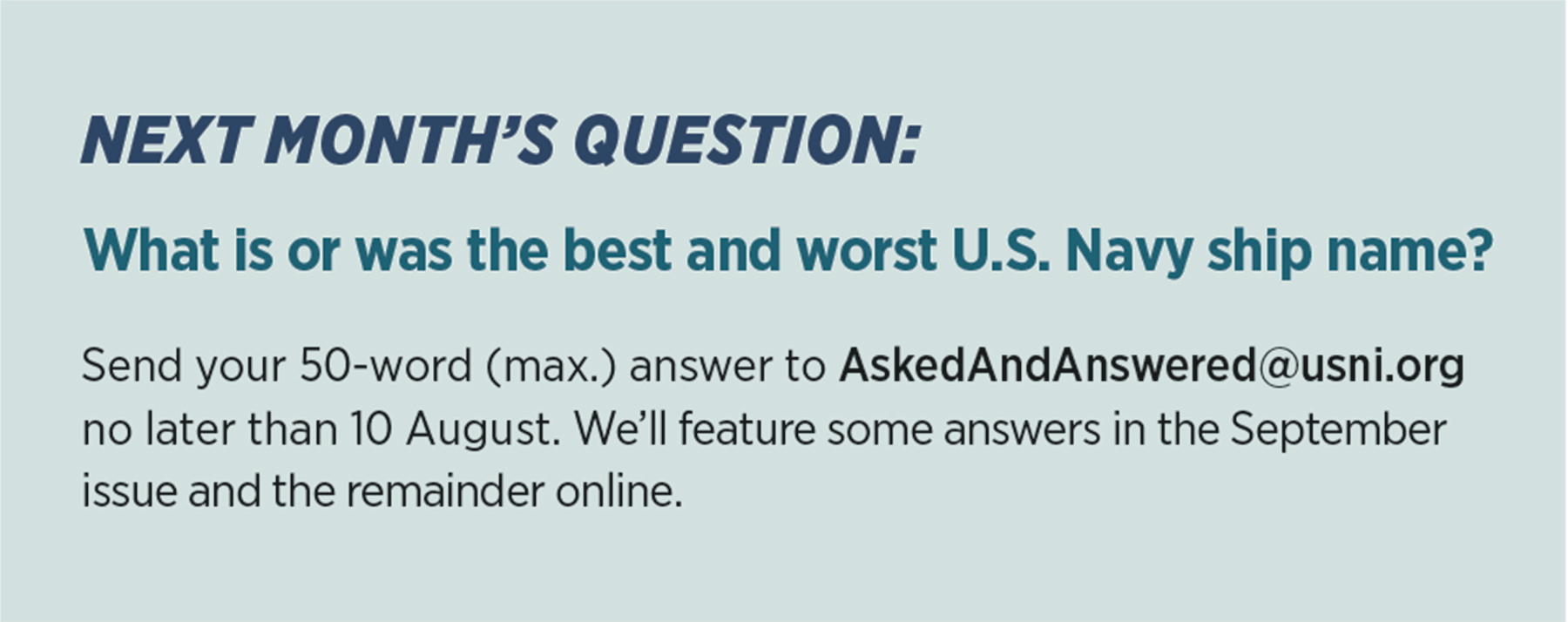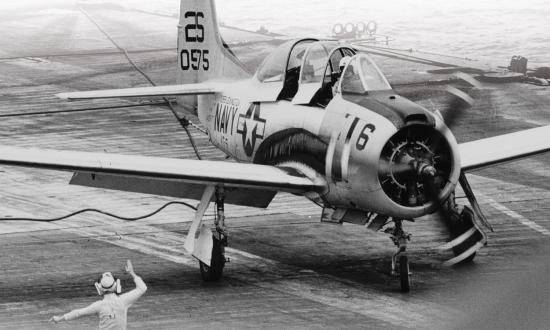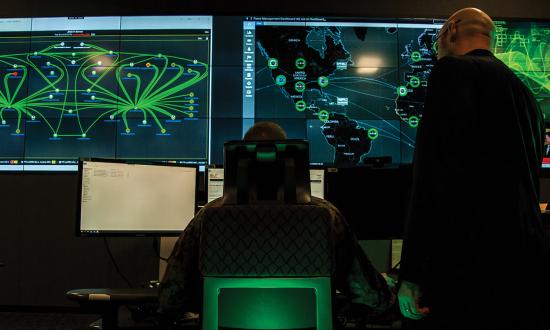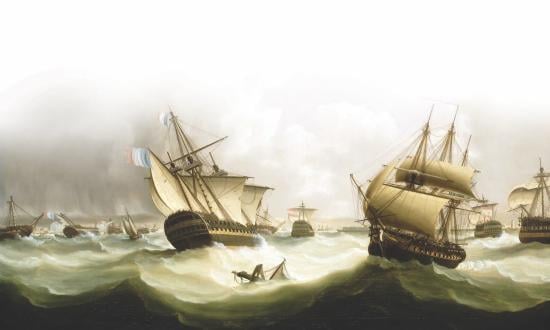Captain Mont J. Smith, U.S. Coast Guard (Retired)
The MV Marine Electric sinking on 12 February 1983 off Chincoteague, Virginia. Navy and Coast Guard helicopters responded as quickly as possible. On-scene conditions were brutally cold. Few of the crew were saved, but the case prompted the Coast Guard to establish the rescue-swimmer program and improve marine inspection.
Commander Jennifer Runion, U.S. Coast Guard
The USCGC Morgenthau (WHEC-722) was on search-and-rescue standby for the Bering Sea Crab Derby in 2003 when alerted to a sinking fishing vessel. We launched the helicopter in heavy seas and it, along with another helo, rescued all five crewmembers. The video is in the opening credits of Deadliest Catch.
Commander Craig Allen, U.S. Coast Guard
Patrolling the Florida Straits in the USCGC Venturous (WMEC-625) in 2004, we intercepted a fully amphibious 1959 Buick—complete with a propellor connected to the drive shaft and bow welded to the front—making way with 11 migrants on board. To stop the aquacar, we threatened to pour sugar into the gas tank. The migrants saw that and agreed to disembark.
Master Chief Ken Cochran, U.S. Coast Guard (Retired)
The tug Eagle sinking in the Gulf of Alaska 65 miles southeast of Yakutat with nine people on board on 27 October 1983 in 50-foot seas, 70-knot winds, and heavy rain. We hoisted the lone survivor in the worst conditions of my 30-year career. The HH-3F was a great search-and-rescue aircraft!
Captain Art Wagner, U.S. Coast Guard (Retired)
On 10 September 1965, Hurricane Betsy left men, women, and children scrambling to the roof of a school shelter in New Orleans as flood waters from a broken dike suddenly rose inside. We made 25 HH-52A Seaguard helicopter hops from Coast Guard
Air Station Houston, saving 218
people in three hours.
Commander Ronald D. Stenzel, U.S. Coast Guard (Retired)
On 3 April 1972, as an aircraft commander representing the U.S. government, I arrested the crews of two large Japanese fishing vessels for violating U.S. law in the far north Pacific. What is unusual is the arrest was accomplished from a HC-130H aircraft. Just as with land-based police, as long as the aircraft kept in contact with the vessel we could consummate an arrest. A Coast Guard vessel would later do the physical arrest.
Lieutenant Commander David F. Cooper, U.S. Coast Guard (Retired)
The image of Primo Castillo, the missing first engineer/electrician from the sunk MV Antilles Sun, when we found him in late February 1982, arms draped over a supporting wood box, hands together like the sketch “Praying Hands.” Later, Mr. Castillo told interviewers he had been praying all night for rescue, but when morning broke with no search assets in sight, he had asked for a shark to put him out of his misery.
Chief Petty Officer John Furqueron, U.S. Coast Guard (Retired)
On 16 April 1972, our mission was to fly out to Cat Cay in the Bahamas, pick up an adult male suffering from the bends, and transport him to the decompression chamber in Miami. During flight, our corpsman was trying to settle him down but was having problems. As we approached our landing at the marine lab pressure chamber, I was leaning out the door watching the tail rotor when I sensed a problem inside. The patient had sat up, grabbed a survival knife, and was trying to stab the corpsman. I jumped on the patient and tried to wrestle the knife from him. All this time the pilots were asking over the intercom what was shaking the helo. My mike was torn from my helmet and neither I nor the corpsman could talk. We landed safely and I held the patient until he let go of the knife. It was a search-and-rescue case I will never forget.
Commander Ronald D. Stenzel, U.S. Coast Guard (Retired)
On 3 April 1972, as an aircraft commander representing the U.S. government, I arrested two large Japanese fishing vessels and their crew for violating U.S. law in the far north Pacific. What is unusual is the arrest was accomplished from a HC-130H aircraft. Just as with land-based police, as long as the aircraft kept in contact with the vessel we could consummate an arrest. A Coast Guard vessel would do the physical arrest.
Lieutenant Commander N. Ted Ohr, U.S. Coast Guard (Retired)
Flying the HU-16 Grumman Albatross during the 1980 Cuban Mariel Boatlift and spotting a raft made of inner tubes and plywood with a few desperate people on it. Vectored a Coast Guard cutter in to pick them up. Not sure they would have survived.
Chief Petty Officer Otto P. Schlicht II, U.S. Coast Guard
On 6 March 2004, the taxi boat Lady D operating in Baltimore Harbor capsized in a fast-moving storm with high winds. The Fire Deptartment and Navy Reserve rescued the majority of passengers. Unfortunately, five passengers died, including a young child. I will never forget being on scene when the child was recovered. Truly a sad moment.
Commander Bob Mueller, U.S. Coast Guard (Retired)
In 1972, in far western Alaska waters, from the air we observed a Coast Guard buoy tender tied off to Soviet cannery ship with the boarding party locked in Soviet vessel communications center. The Soviet vessel got underway headed west and refused to heed international signals to stop. We fired pistol flares at the ship from our C-130. We saw one enter the ship’s bridge before we had to leave the scene.
Captain Peter A. Poerschke, U.S. Coast Guard (Retired)
The Heering Kirse case of 1971. I was a new H-130 copilot and a newly wed living at Barbers Point, Hawaii. The phone rang in the middle of the night. The operations center said a ship was sinking off Midway Island. I told my bride to quickly pack me a bag for a few days and off I flew. After a joint search effort with the Navy, which included a midair with a P-3 Orion (no casualties), I returned almost a month later. Recovered most but not all of the ship’s crew.
A starboard-side view of the migrant truck raft (a 1959 Buick) intercepted by the USCGC Venturous (WMEC-625) in 2004 in the Florida Straits. U.S. Coast Guard
Master Chief Tom Scoggins, U.S. Coast Guard (Retired)
On 16 November 1972, I was on a Kodiak C-130 dropping 55-gallon drums of mogas to the grounded USCGC Jarvis (WHEC-725) along the Aleutian Islands. During the second drop, the aircraft commander told the copilot to take control because he had vertigo. The copilot said he had vertigo, too. I told the pilots I had the aircraft and, using the autopilot, flew it from the flight engineer seat until the commander could take control again.
Captain Samson C. Stevens, U.S. Coast Guard
On 7 June 2022, I was at Coast Guard Training Center Yorktown, Virginia, providing a crisis communication presentation on a Navy E-2D Hawkeye rescue case near Assateague Island, when I received the call that the MV Spirit of Norfolk was on fire in Norfolk Harbor with more than 90 children and 17 crew on board.
Captain Pat Lineberry, U.S. Coast Guard
In October 2016 in the eastern Pacific, I was on my first helicopter interdiction tactical squadron deployment. We were covertly following a target of interest, when over the radio: “District 11 has issued a statement of no objection to compel compliance with international law.” The gunner racked his machine gun, announcing: “Ready aft!” Ten minutes later, the vessel was dead in the water with several 50-caliber holes in its engine.
Lieutenant Commander Roger P. Bowers, U.S. Coast Guard (Retired)
First life saved by a HU-25A Falcon Jet—15 September 1982 from Mobile, Alabama. The crew spotted William T. Ames of Pensacola, who had fallen overboard from pipeline barge Cherokee approximately 90 miles south of New Orleans. A former Marine, Ames knew to remove his jeans, tie the ankles, and fill his trousers with air. He was 10 hours in the Gulf before an HH-3F Pelican helicopter rescued him.
Captain George Krietemeyer, U.S. Coast Guard (Retired)
In 1964, I was flying the HU-16E Albatross out of Coast Guard Station Miami searching for several boats that had declared May Day. When a crewman reported something in water, we flew over and found three people on a large hatch cover. It was too rough for us to land, so a new amphibious helicopter from St. Petersburg picked up two men while a deceased woman floated away in shark-infested waters.
Captain Alberto J. Gaston, U.S. Coast Guard (Retired)
During the response to the 1980 Cuban Mariel Boatlift crisis, I deployed from Air Station Cape Cod to Naval Air Station Key West and flew HH-3Fs above the constant stream of civilian boats going to and coming back from Cuba. Probably the first time Coast Guard aviation mixed and matched crews from all over to respond to a national incident.
Master Chief Bill James, U.S. Coast Guard (Retired)
During a drug interdiction 1,000 nm off Canada’s west coast on board the USCGC Acushnet (WMEC-167), we snuck up on an 85-foot sailing vessel. The master set fire to vessel and the burned crew abandoned ship. We recovered the crew and 85 tons of hashish. The sailboat sank.
Lieutenant Commander Dave Herndon, U.S. Coast Guard
I was the last person to speak to the master of the SV Rebel Heart via satellite phone. They were disabled in heavy seas with a critically ill one-year old more than 900 nm west of Cabo San Lucas, Mexico. His phone ultimately died and he activated his EPIRB. Over the next two days, I orchestrated a rescue effort involving U.S. Coast Guard assets, U.S. Air Force pararescuemen, and the U.S. Navy Assets, ultimately saving the family and the little girl.
Petty Officer First Class George H. Gibault, U.S. Coast Guard (Retired)
The 20 October 1978 sinking of the training vessel Cuyahoga (WIX-157) in the Chesapeake Bay following a collisoon, a tragedy that need not have happened. We lost eleven Coasties that night—it hit home hard. I knew a person who survived the sinking. He was lucky!
Captain Jimmy Ng, U.S. Coast Guard (Retired)
My best friend and his crew flew on a night search-and-rescue case off of Montague Island, Alaska, on 6 August 1981. They crashed while attempting to hoist a single fisherman whose vessel had lost power and was sinking in the violent storm. Placing the target in clear view through my chin bubble, I carefully landed my HH-3F between beach boulders on Montague Island, Alaska. I jumped out, knelt down, and gently turned him over. I looked into my good friend Lieutenant Pat Rivas’ face, but he was no longer there. I wept.
Commander William Calderwood, U.S. Navy (Retired)
While standing radio direction finding watch atop Point Loma San Diego in the late 1990s, I became aware that an unoccupied small boat had been found off shore to the north indicating a possible man overboard. At the same time, I noticed the westbound Fuji blimp approaching the coast line. A prompt response was required inspiring me to contact the U.S. Coast Guard operations center to enlist the blimp in the initial search. This was done, but unfortunately later the man was found dead when other search assets arrived on scene.
Warrant Officer Andrew S. Kalbrener, U.S. Coast Guard
In 2013, while on board the medium-endurance cutter Forward (WMEC-911), we rapidly diverted from a shakedown cruise in the Chesapeake Bay to respond to a disabled sailboat 200 miles off South Carolina. An anticipated four-hour shakedown cruise on a Friday turned into a three-day search-and-rescue case with no preparation. All lives and property saved.
Commander Baxter B. Smoak, U.S. Coast Guard
The March 2022 MV Ever Forward grounding in the Chesapeake Bay will be forever engrained in my memory. I don’t know if that is because of the 35 days of little sleep or our team’s success in refloating the ship without pollution or injury while mitigating any adverse impacts to commerce.
Rear Admiral Scott Clendenin, U.S. Coast Guard (Retired)
The USCGC Seneca (WMEC-906) January 1997 rescue of two crewmembers from the fishing vessel Trinity off Montauk, Long Island. Seneca crew members had to go out on the fantail to retrieve the fisherman from the raft once alongside. As the ship rolled in the 20-foot waves and heavy water came over the fantail, a cable was placed across the deck of the fantail so the crew could clip in. The survivors reported that as the cutter maneuvered up swell, they could see the propellers in the air in the ambient light with each set of waves.
Captain R. J. Copin, U.S. Coast Guard (Retired)
In 1972 as an HH-3F aircraft commander in command of Air Station Annette Island, Alaska, I piloted a helicopter in response to a report of a person missing in the desolate area east of St. Petersburg. He was last known in hills 2,000 feet above sea level. We found the area and descended. There was a man waving and staggering. We landed on the grass and retrieved him. He was in shock.
Petty Officer J. D. Lawrence, U.S. Coast Guard (Retired)
Flying to the offshore target area from Jacksonville, Florida, the morning of September 11, and getting the recall to base.
Commander Al Antaran, U.S. Coast Guard (Retired)
Last leg of a search-and-rescue off Puerto Rico, my crewman says, “Look at the whale!” I glanced over and it was the bow of a boat with its sole survivor hanging on for the past 24 hours. “That’s no whale, that’s our missing guy!”
Michael Smith, U.S. Coast Guard Veteran
On 15 June 1967, our Coast Guard HU16-E 7237 departed Coast Guard Air Station Annette, Alaska, to search mountainous terrain in the Atlin Lake region of British Columbia for an overdue aircraft. After three hours on scene, we located the aircraft, which had impacted a steep mountain. The cockpit crew perished, but the three aft survived.
Commander Allen W. Penn, U.S. Coast Guard Reserve (Retired)
Following the Exxon Valdez grounding in Prince William Sound, Alaska, in spring 1989, I accepted the position as first duty officer to stand up the U.S. Coast Guard Headquarters’ Crisis Action Center. I manned the center for 11 days straight, usually following my regular civilian workday at Headquarters.
Captain Ian Bastek, U.S. Coast Guard
Flying HC-130Hs out of Central America in February 2005, we detected two contacts about 10 miles apart. The first was a go-fast next to a logistics vessel and the second was one of our cutters with the crew at quarters on the flight deck. We woke them up and got a good bust!
James Fridireci, U.S. Coast Guard Veteran
During summer 1973, a 40-foot utility boat from Coast Guard Station Marblehead observed a pleasure boat very low in the water. On boarding, the 40-footer’s crew determined the new boat owner had launched his boat with the trailer still attached. The 40-footer escorted the boat to the launch ramp and stood by until the boat was back on its trailer and out of the water. No citations were issued because in those days Coast Guard policy was on safety and education rather than writing tickets for recreational boaters.
Captain David L. Teska, U.S. Coast Guard Reserve (Retired)
In late 1990 at Group Seattle, I was a new ensign standing search-and-rescue controller watch when a case came in of a fisherman in hip waders who tried to jump from a barge to the dock but didn’t make it and went into the water. We sent a 41-foot boat and dispatched a HH-65 from Air Station Port Angeles. When on scene, the helicopter crew reported rescuers had found his body. The hip waders had rapidly filled with water when he went in, pulling him under.
Kristy Kiernan, U.S. Coast Guard Veteran
In July 1998, at 4:00 am in worsening weather, two brothers overdue on a fishing trip in the Gulf of Mexico. Their dad listening on the radio as we searched the pitch-black sea. Pinprick of light in the darkened water. The sound of dad’s voice when we told him his sons were coming home.
Captain Mike Emerson, U.S. Coast Guard (Retired)
In 1993, my first aerial delivery rescue of FV Anna Riley. We found her taking on water more than 700 miles south of Oahu. I imagined myself throwing an empty bottle at a street sign and my first drop was perfect. I didn’t miss a sign that night.
Captain Paul Ibsen, U.S. Coast Guard Reserve (Retired)
17 May 1980, flying a HH-52A during the Mariel, Cuba exodus, a crewman spotted a swamped vessel. Survivors hanging onto the boat and debris. When the eleventh arrived at the helicopter door, the hoist burned out. Of 52 people on the boat, 38 were saved, 10 perished, and 4 were lost.
Captain Patrick Harris, U.S. Coast Guard (Retired)
On 9/11 in one minute, the Coast Guard’s focus changed and we led the way. On day one we closed the port and initiated the evacuation of 500,000 people from Manhattan. By the end of the week, we increased our manpower 300 percent to set a 24/7 watch over the port.
Commander Chris Kilgore, U.S. Coast Guard Reserve (Retired)
Burning oil tanker, explosions, sea ablaze. Two shipmates on covered aft deck, standing on the wooden rail, the deck searing hot. Despite turbulence, we maneuvered close enough to swing the basket to them—the only two survivors of the MV Burmah Agate. We then hoisted 21 more from the fiery freighter MV Mimosa.



